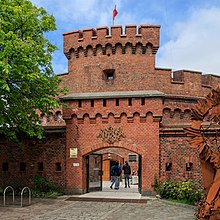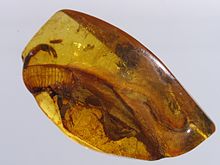Kaliningrad Amber Museum
The Kaliningrad Amber Museum ( Russian Музей янтаря ) in Dohna tower in Kaliningrad was opened 1979th The collection includes amber natural forms , amber inclusions and amber artifacts.
history
The founding of the museum was decided back in 1969. The restoration of the site (Dohna Tower) took around ten years. When it opened on December 29, 1979, the museum was a branch of the Kaliningrad Art and History Museum. In the first few years of its existence, the museum attracted up to 400,000 visitors a year.
After overcoming a difficult period in the transition period, the Amber Museum was spun off from the Museum of History and Art in March 2003. With the legal independence of the still state institution, the development of the museum took a dynamic course. The museum holds exhibitions in the Kaliningrad region and started issuing its own publications, for which an international interest developed.
In 2005, an international competition for amber work in the amber region was held for the first time with participants from Japan and eight European countries. Since then, this competition has been held every two years under the title “Alatyr” (“Alatyr” is an Old Russian name for amber).
On the occasion of the city's 750th anniversary in 2005, the Amber Museum in Kaliningrad showed masterpieces of amber art from the 16th to 18th centuries. Century of the state museum " Tsarskoe Selo " from the world-famous Amber Room . This was followed by further exhibitions of historical amber objects, also internationally recognized, among others in cooperation with the Hermitage Saint Petersburg and the Armory of the Moscow Kremlin . In 1978, the armory donated some very valuable exhibits from the 17th and 18th centuries for the collection of the Kaliningrad Amber Museum.
Over time, the museum has developed into a cultural center of the city of Kaliningrad and a tourist attraction for domestic and foreign guests. The number of museum visitors grew from 90,000 in 2003 to 236,000 in 2008. The income of 2.5 million rubles in 2005 could be tripled by 2008. In 2013, around 1,300 tours took place in the museum, which organized around 30 exhibitions in that year alone.
The museum collection
The museum collection comprises around 14,000 objects: amber objects from the Neolithic , historical and contemporary works by domestic and foreign artists, rare inclusions in amber and natural amber shapes, including the largest piece of amber that can be seen in Russia, weighing more than four kilograms.
The numerous outstanding objects in the collection include a model of a panel of the reconstructed Amber Room in the Catherine Palace in Tsarskoye Selo on a scale of 1: 5, which the museum was involved in producing and which once played a decisive role in the decision-making process for the reconstruction of the “eighth wonder of the world” and as an example of “monumental art”, which was very much appreciated in Soviet times, the faithful replica of the model of the atomic icebreaker “Lenin”, which a Soviet delegation of diplomats had given American President Dwight D. Eisenhower as a gift in 1960.
The museum has a library on amber jewelry and amber carving and maintains a scientific archive. In 2014 the number of self-edited publications had grown to 26. Most of these publications are bilingual (Russian and English).
The 28 exhibition rooms of the museum, located on three floors of the Dohna Tower, cover an area of around 1000 m².
The exhibition is thematically divided into five areas:
- The formation of amber and its properties.
- Amber in archeology and history.
- Amber in 17th and 18th Century Art.
- The Kaliningrad Amber Combine .
- Amber in contemporary art.
Part of the exhibition is dedicated to the State Amber Manufactory in Königsberg , which went under in 1945 .
Perspectives
In 2013, the city and the Kaliningrad Oblast presented plans to renovate the building of the former state amber factory in Königsberg at 6 Sattlergasse (today: 3 Portowaja Street / Serpuchowskaja Street) and make it usable for exhibitions at the Kaliningrad Maritime Museum and the Kaliningrad Amber Museum shall be.
In the building threatened by decay, a copy of the Amber Room, which has been lost since the end of the Second World War, is to be set up in a 16 square meter and five meter high room at an estimated cost of around 2.5 million euros. It is intended to produce a scientifically accurate reconstruction of the Amber Room, as it were of the faithful replica that has been seen in the Catherine Palace of Tsarskoe Selo since 2003. The Ministry of Defense responsible for the building has already approved the handover of the building, which was used as a dormitory until 2009 and has been vacant since then, to the Kaliningrad Amber Museum.
literature
- T. Yu. Suvorova: For the 30th anniversary of Kaliningrad Amber Museum: pages of biography . In: Kaliningrad Amber Museum . Kaliningrad 2008, p. 7-20 .
- VM Popova: Amber Room . In: Kaliningrad Amber Museum . Kaliningrad 2008, p. 73-80 .
- Z. Kostyashova: Collection of the Kaliningrad Amber Museum . In: Composition, Collection Principles and Special Uses . Kaliningrad 2007. pp. 18-26.
Web links
- Homepage of the Kaliningrad Amber Museum. Retrieved April 10, 2015 (Russian, unknown language, English).
- Kaliningrad Amber Museum. Retrieved April 10, 2015 (Polish, unknown language, English).
Individual evidence
- ↑ Zoja Kostyashova: The History of the Kaliningrad Amber Factory, 1947 - 2007 , Kaliningrad of 2007.
- ↑ Königsberger Express 1/2013, p. 12 f.
- ^ East Prussia portal.
Coordinates: 54 ° 43 ' N , 20 ° 31' E







